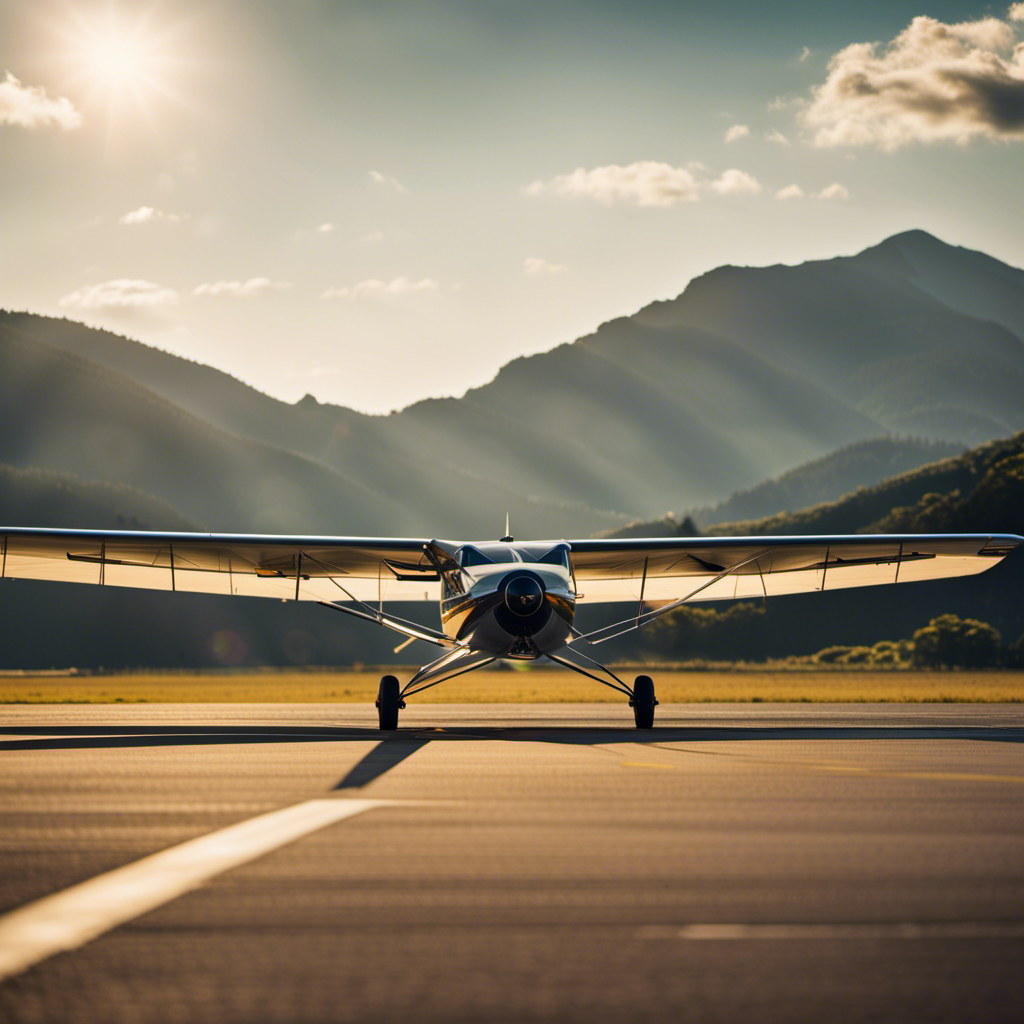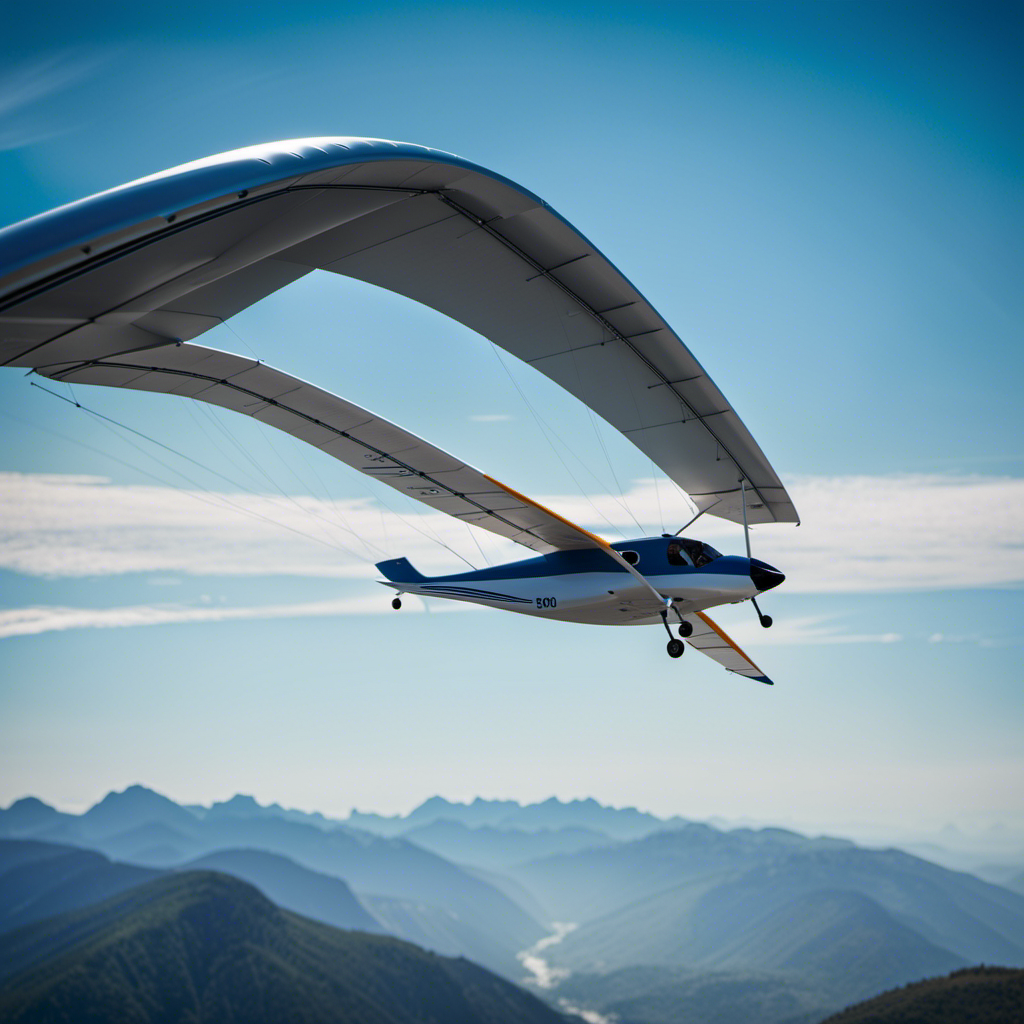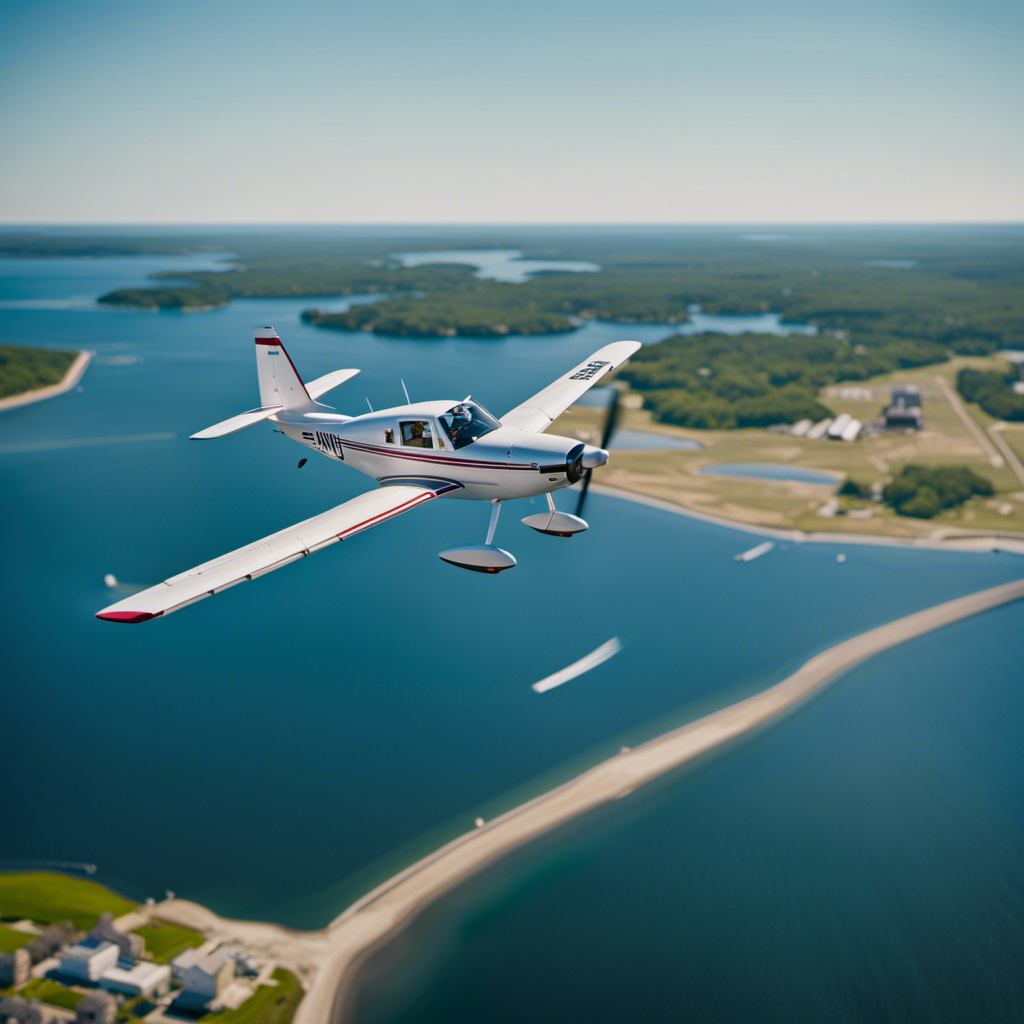As an experienced glider pilot, I’ve felt the excitement of flying high, rising from the earth to spectacular heights.
If you’ve ever dreamt of mastering the art of gliding, this complete guide to glider training is your ticket to achieving that dream.
From understanding the basics of aerodynamics to perfecting advanced maneuvers, this article will equip you with the knowledge and skills needed to navigate the skies with confidence.
Get ready to embark on an exhilarating journey of flight, where the sky truly is the limit.
Key Takeaways
- Effective communication during emergencies is essential for glider pilots.
- Landing techniques in glider training require maintaining proper speed and control for a smooth touchdown.
- Advanced maneuvers in glider flight require high skill and precision.
- Comprehensive glider training manuals, online forums, and workshops/seminars are valuable resources for developing skills in glider training.
The Basics of Aerodynamics
Understanding the basics of aerodynamics is crucial for a successful glider training experience. As a glider pilot, I have learned firsthand how important it is to comprehend the principles that govern the movement of air around the aircraft.
Aerodynamics is the study of how objects, like gliders, move through the air. It involves concepts such as lift, drag, and thrust.
Lift is the force that allows a glider to stay airborne, while drag is the resistance that opposes its forward motion. Thrust, on the other hand, is the force that propels the glider forward.
By understanding these key principles, pilots can manipulate the air around the glider to achieve efficient and controlled flight.
With a solid foundation in aerodynamics, we can now delve into the fascinating world of flight mechanics.
Flight Mechanics
When it comes to flight mechanics, mastering the control of pitch, roll, and yaw is essential.
As a seasoned pilot, I have learned the importance of understanding how to manipulate these movements to maintain stability and control in the air.
Additionally, a key aspect of flight mechanics is the effective use of flaps and spoilers, which can greatly impact the aircraft’s performance and maneuverability.
Controlling Pitch, Roll, and Yaw
To control the pitch, roll, and yaw of a glider, you’ll need to use the control surfaces effectively.
The pitch is controlled by the elevator, which is located at the tail of the glider. By moving the elevator up or down, you can change the angle of the glider’s nose.
The roll is controlled by the ailerons, which are located on the wings. When you move the ailerons up on one wing and down on the other, the glider will roll in that direction.
Lastly, the yaw is controlled by the rudder, also located at the tail. Moving the rudder left or right will cause the glider to yaw in that direction.
By mastering the control surfaces and their movements, you can maneuver the glider with precision and grace.
Now, let’s explore how to master flaps and spoilers.
Mastering Flaps and Spoilers
The glider’s flaps and spoilers can be used to enhance its performance during different phases of flight. These control surfaces play a crucial role in maneuvering the glider and optimizing its aerodynamic characteristics. The flaps, located on the wing’s trailing edge, can be extended to increase lift and decrease stalling speed during takeoff and landing. On the other hand, spoilers, situated on the wing’s upper surface, are used to decrease lift and increase drag, allowing for controlled descent and speed reduction. By manipulating these surfaces, pilots can fine-tune the glider’s performance and improve its efficiency.
| Control Surface | Function | Usage |
|---|---|---|
| Flaps | Increase lift, decrease stalling speed | Takeoff, landing |
| Spoilers | Decrease lift, increase drag | Descent, speed reduction |
Mastering the operation of flaps and spoilers is crucial for a successful glider flight. It allows for precise control and maneuverability, ensuring a safe and enjoyable experience in the air. Now, let’s delve into the next section, where we will explore the essential steps for preparing for takeoff.
Preparing for Takeoff
Before you take off in a glider, it’s important to properly prepare for the flight. As an experienced glider pilot, I have learned the significance of thorough pre-flight preparations. Here are some key steps I follow to ensure a safe and successful takeoff:
- Conduct a thorough inspection of the glider, checking for any signs of damage or wear.
- Verify that all control surfaces are functioning properly by performing a pre-flight control check.
- Ensure that the flaps and spoilers are working smoothly and responding correctly.
- Confirm that the instruments, such as the altimeter and variometer, are calibrated and functioning accurately.
By meticulously completing these tasks, you can be confident that your glider is in excellent condition for takeoff.
Now, let’s delve into the exciting world of soaring techniques, where we will explore how to maximize your flight time and reach new heights.
Soaring Techniques
Now, let’s dive into the exciting world of soaring techniques and discover how to maximize your flight time and reach new heights.
Soaring is all about harnessing natural sources of lift, such as thermals, ridge lift, and wave lift, to sustain and extend your flight. Understanding how to find and use these lift sources effectively is essential for a successful glider pilot.
One technique is circling in thermals, where you gain altitude by flying in a circular path within a thermal column.
Another technique is ridge soaring, where you fly along the windward side of a ridge, utilizing the upward air currents generated by the wind hitting the ridge.
By mastering these techniques, you can stay aloft for longer periods and explore new areas.
Now, let’s transition into the next section on navigation and flight planning.
Navigation and Flight Planning
Let’s start by discussing how to effectively navigate and plan your flights using the tools and resources available to you. As a seasoned glider pilot, I’ve learned the importance of thorough planning and using the right tools to ensure a safe and successful flight.
Here are a couple of key points to consider:
-
Pre-flight planning:
-
Study the weather conditions, wind patterns, and thermal activity in the area.
-
Analyze the terrain and identify potential landing spots in case of emergency.
-
In-flight navigation:
-
Use a GPS device or electronic flight computer to track your position and monitor progress.
-
Familiarize yourself with sectional charts and airspace restrictions to avoid violations.
By following these guidelines, you can enhance your navigation skills and make informed decisions during your flights.
Now, let’s move on to the next section, where we’ll explore the importance of communication in the sky.
Communication in the Sky
Ensure clear and effective communication with other pilots and air traffic control by using the correct radio frequencies and following standard communication protocols.
As a glider pilot, maintaining open lines of communication is crucial for safe and efficient flying. Familiarize yourself with the specific frequencies designated for glider operations in your area, and always adhere to proper radio etiquette.
When contacting air traffic control, state your callsign, position, and intentions clearly and concisely. Be prepared to listen attentively and follow instructions promptly.
In the event of an emergency, effective communication becomes even more critical. Transitioning into emergency procedures, it is vital to remain calm and transmit a clear distress message, providing relevant details about your situation.
Knowing how to communicate effectively during emergencies can save lives and aid in a swift and coordinated response.
Emergency Procedures
After mastering effective communication in the sky, it’s time to turn our attention towards a critical aspect of glider training – emergency procedures. As a seasoned glider pilot, I have encountered various emergency situations and learned the importance of being prepared for the unexpected.
Here are three key emergency procedures that every glider pilot must be well-versed in:
-
Forced Landing: In the event of a mechanical failure or loss of lift, executing a safe forced landing is crucial. This involves selecting an appropriate landing area and following the correct procedures to minimize the risk of injury.
-
Spin Recovery: If a glider enters into a spin, swift action is required to recover control. Knowing the correct control inputs and following the recovery procedure can help stabilize the aircraft and prevent a potentially dangerous situation.
-
Canopy Release: In rare cases of emergency, it may become necessary to quickly exit the glider. Understanding the proper sequence of releasing the canopy and deploying the parachute is vital for a successful evacuation.
With emergency procedures firmly ingrained in our minds, we can now move on to the next section – landing techniques, where precision and finesse play a crucial role.
Landing Techniques
In landing techniques, it’s important to maintain proper speed and control to ensure a smooth touchdown. As a seasoned glider pilot, I have learned that executing a successful landing requires precision and finesse.
One must carefully manage the glider’s airspeed, using the correct approach angle and descent rate. By adjusting the elevator control and spoilers, I can control the descent and reduce the glider’s speed.
As I approach the ground, I gently flare the glider, raising the nose slightly to bleed off remaining speed. This allows for a gentle touchdown, minimizing the risk of bouncing or damaging the aircraft.
Mastering these techniques is crucial before moving on to advanced maneuvers, where pilots can push their skills to the limit and perform thrilling aerobatic maneuvers that showcase the full potential of glider flight.
Advanced Maneuvers
Executing advanced maneuvers in a glider requires a high level of skill and precision. These maneuvers, such as loops, spins, and stalls, push the boundaries of what a glider is capable of.
As a seasoned glider pilot, I have had the opportunity to perform these maneuvers and witness their sheer exhilaration. Looping through the sky, feeling the G-forces press against my body, is an experience like no other. Spins, on the other hand, test your ability to recover from a stalled condition, requiring quick thinking and precise control inputs.
These advanced maneuvers are not for the faint of heart, but with proper training and practice, they can be mastered. Now, let’s delve into the glider training resources that will help you develop the necessary skills for these exciting maneuvers.
Glider Training Resources
You can find a variety of resources available to help you develop the necessary skills for mastering advanced glider maneuvers. As someone who has been involved in glider training for years, I can attest to the importance of utilizing these resources to enhance your skills and knowledge.
One of the most valuable resources is a comprehensive glider training manual. These manuals provide detailed explanations of advanced maneuvers, along with step-by-step instructions on how to properly execute them. They also include diagrams and illustrations to further aid your understanding.
Additionally, online forums and communities dedicated to glider training are excellent resources for sharing experiences and seeking advice from experienced pilots. These platforms allow you to connect with a network of individuals who share your passion and can offer valuable insights.
Finally, attending workshops and seminars led by seasoned glider pilots is another great way to enhance your skills. These events provide hands-on training, allowing you to practice advanced maneuvers under the guidance of experts.
Frequently Asked Questions
What are the physical fitness requirements for glider training?
To train for glider flying, you need to meet certain physical fitness requirements. These include having good cardiovascular endurance, strength, and flexibility. Regular exercise, such as running and weight training, can help improve your fitness for glider training.
How long does it typically take to become a certified glider pilot?
Becoming a certified glider pilot typically takes around 6-12 months, depending on the individual’s dedication and progress. It involves completing ground school, flight training, and passing written and practical exams.
Are there any age restrictions for glider training?
There are age restrictions for glider training. In most countries, the minimum age to start training is 14 years old. However, some countries may have different age requirements, so it’s crucial to check with your local aviation authority.
Can I use my own glider for training or do I have to rent one?
Yes, you can use your own glider for training. Renting is an option, but having your own allows for familiarity and customization. It’s like having a well-worn glove, perfectly molded to your hand, giving you an edge in your training.
What type of weather conditions are suitable for glider training?
Suitable weather conditions for glider training include clear skies, moderate winds (5-15 knots), and stable atmospheric conditions. Wind direction should allow for safe takeoffs and landings. It is important to avoid turbulent or extreme weather conditions for training purposes.
Conclusion
After months of diligent training and countless hours in the sky, glider training has transformed me from a novice to a skilled pilot.
The journey from ground to glory has been an exhilarating one, filled with ups and downs. But through it all, I have gained a deep understanding of the intricacies of aerodynamics and flight mechanics.
Armed with this knowledge, I am now ready to take on the world of gliding with confidence and finesse.
So spread your wings and soar, fellow aviators, for the sky is our limitless playground.
With a heart that soars as high as the skies, Aria, affectionately known as “Skylark,” is the driving force behind Soaring Skyways. Her journey into the gliding world began as a young dreamer gazing up at the soaring birds, yearning to experience the weightlessness and freedom they embodied. With years of experience both in the cockpit and behind the scenes, Aria’s commitment to the gliding community is unwavering.









